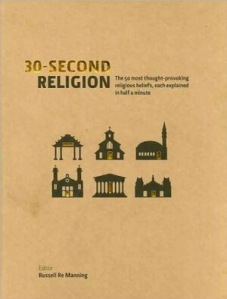Title: 30-Second Religion: The 50 Most Thought-Provoking Religious Beliefs, Each Explained in Half a Minute
Editor: Russell Re Manning
Genre: Religion
Trigger Warnings: None noticed
Back Cover:
Sikhism, Lutheranism, Islam, Judaism, and Spiritualism? Sure, you’ve certainly heard of them, but do you understand enough about these religious beliefs to quench your thirst for enlightenment or join a dinner party debate on the diversity of world religions?
30-Second Religion demystifies the key beliefs of the world’s major religions, denominations, and less widespread sects, and explains them to the general reader in half a minute, using nothing more than two pages, 300 words, and one picture. Whether you want to understand the key differences between Lutheranism and Calvinism or take in a brief overview of Buddhist philosophy, this book is the quickest way to walk the paths and recognize the key signposts of the world’s diverse and fascinating faiths. Travelling from Animism to Zoroastrianism, and including features on seven key religious texts, 30-Second Religion offers an engaging guide to 50 fascinating belief systems.
Review:
I want to preface this review by saying that I bought this book when my interests were slightly different. I still find religions fascinating and enjoy both learning about real-world religions and reading stories with rich fictional religions. However, my interest now is less general and academic and more about specific things about religion that I find neat (e.g. rituals). So I was already primed to like this book less than when I first bought it.
I do commend this book for the wide variety of religions it discusses. There were even some (like Shenism) that I had never heard of before. So if you’re looking for a general list of world religions to explore, the table of contents here would be a good resource.
You may notice that I said “the table of contents” and not “this book,” and there’s a reason for that. I’m not opposed to simplifying things for people with only a casual interest or who want to know about a religion not because they really care but because they met someone who practices it and don’t want to put their foot in their mouth or something. But this book simplifies things so far as to be practically useless. Let’s face it, there’s really no way to distill several millennia of religious writing, debate, and practice into a single paragraph without either ignoring the multiplicity of traditions or being so general as to say hardly anything. 30-Second Religion chose the incredibly general route. This is probably more fair to the religions being presented, but is definitely less helpful to the reader. There was also no real consistency of what information was covered. Some entries were about the religion’s founding and history with very little about beliefs, some purely theology, and some only about important people involved. It also does not even mention any of the current controversies around any of these religions (e.g. the Catholic child rape scandal, the Baptist Abuse of Faith crisis). If its goal is to make you dinner-party conversational like the back cover claims, these seem like glaring omissions.
To make matters worse, the highly-simplified information presented isn’t even always correct. Even judging only the sections I’m qualified to judge – the selection of Protestant Christian faiths presented – it’s full of inaccuracies. The book presents Calvinism as its own denomination/sect even though it’s really a set of “add-on” beliefs that are added in addition to other denominational beliefs. At one point it contrasts the Qur’an and the Bible by saying the Qur’an is believed to be the divine words of god and therefore perfect while the Bible is believed to be written by humans and therefore fallible – while if you know anything about Christians, you know there is a significant portion (possibly a majority) who believe the Bible is the divine and inerrant word of god. If entries for Christianity, the dominant religion in the places this book was marketed, are so full of errors, I can only imagine how many factual inaccuracies are to be found in entries for lesser-known religions.
This book also uses terms like “evangelical” and “cargo cult” without ever defining them, even in the glossary. The terms are used correctly, but the fact that it assumes a basic level of knowledge with the subject’s terminology demonstrates how despite its simplification, this book is not as accessible as it wants to be.
I’m really grasping at straws here, but I do give the book points for being pretty. Each entry’s facing page is a full-page collage of illustrations and photographs of important things to that religion, although some of the images included are strange (on the Christian Science entry, for example, they include a picture of the founder right next to the same picture with colors inverted). The cover has sparkly golden foil, the entries themselves are laid out nicely, and the paper is thick and glossy. And like I said earlier, the table of contents is useful because it’s a pretty comprehensive list of major world religions. But unfortunately, the content ranges from simplified-to-the-point-of-uselessness to just plain incorrect. I legitimately think you’d be better off just reading a Wikipedia article about whatever religion you want to learn. At least Wikipedia has links so you don’t have to Google so many things. It’s impossible to summarize any belief system in just thirty seconds, and if you really want to learn something, it’s best not to try.

